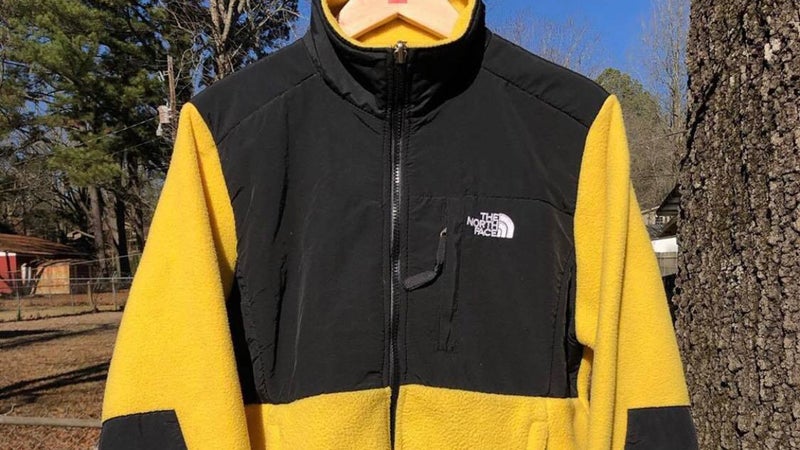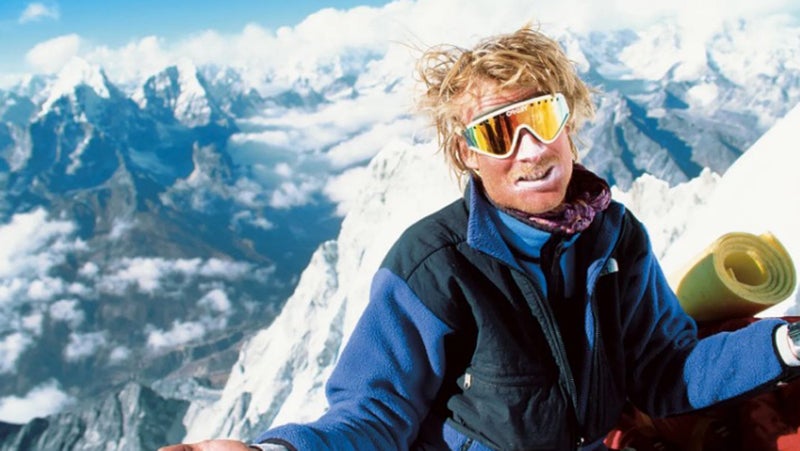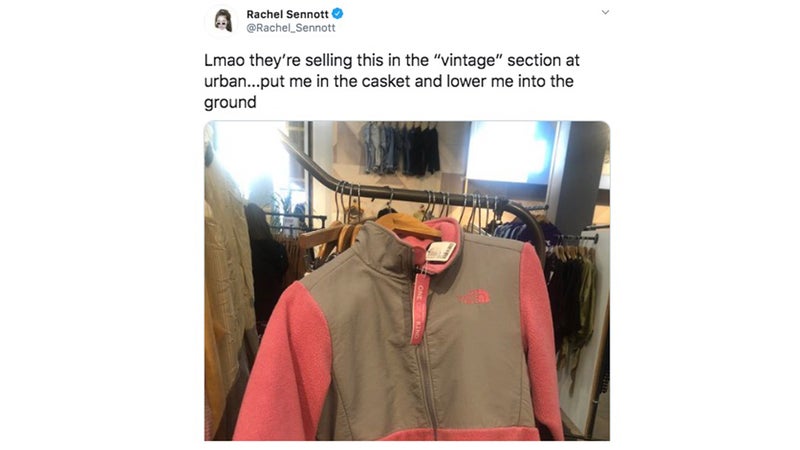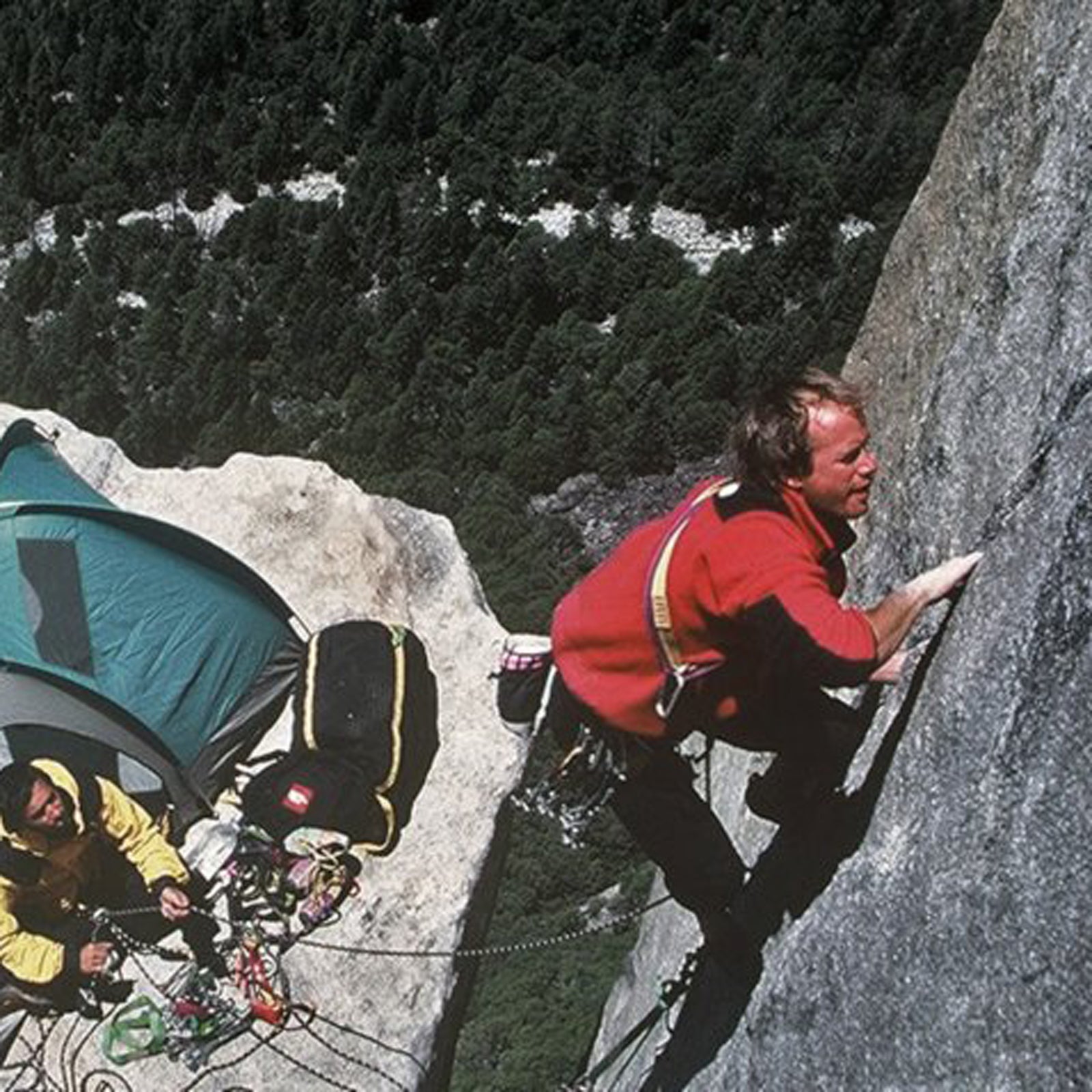Jacob Buchanan immediately gravitates toward the fleece when he notices it in Hope Restored, a thrift store in Searcy, Arkansas. ItÔÇÖs a pale-yellow shade Buchanan has never seen, and itÔÇÖs made by the North FaceÔÇöa recognizable,╠řvalued brand. Score.
Finding and reselling clothes is partially how Buchanan supports himself. In addition to teaching high school English,╠řhe runs an through the app Depop. HeÔÇÖs trying to cut down on his purchasing╠ř(his inventory is starting to spill into his daughterÔÇÖs nursery) but ends up buying the North Face Denali fleece for $1 anyway, because╠řhe knows heÔÇÖll be able to sell it for much more than that.
Through the years, people have worn╠řthe versatile Denali╠řas an outdoors jacket, as streetwear, and╠řas╠řa fashion statement. But one thing is undeniable: few items of clothing have╠řstuck around in popular culture╠řas long as this 32-year-old fleece.

Decades before the fleece was a golden goose for vintage merchants, it was a technical midlayer, an early iteration of which was worn by Todd Skinner and Paul Piana on the first free ascent of╠řEl CapitanÔÇÖs Salath├ę Wall. On June 15, 1988, after ,╠řSkinner and Piana made history by topping out on╠řthe 3,000-foot face. Shortly after, the Denali gained traction among╠řmore casual╠řclimbers, too.╠řTim Bantle, general manager of the North FaceÔÇÖs lifestyle╠řdivision, says the DenaliÔÇÖs ascension dovetailed with the rise of recreational mountaineering and another╠řglobal trend: the deregulation of the airline industry in the early eighties. Suddenly, travel and exploration were affordable for╠řweekend warriors╠řas well as professional athletes. In the fall of 1988, the North Face developed its╠řExpedition System: a suite of gear and apparel tested on the actual peak of Denali╠řbut honed for Mount Everest and the Himalayas. The collection included shells, down jackets, tents, booties, backpacks, and,╠řof course,╠řthe Denali fleece.

Conrad Anker, a╠řNorth FaceÔÇôsponsored mountaineer since 1983,╠řwas one of the first to actually╠řwear the fleece on Denali in 1989, though he says the first ÔÇťbigÔÇŁ expedition he took the jacket on╠řwas to . He liked the jacket for its technical chops, and because it served as an excellent makeshift pillow when turned inside out. The abrasion patches at the shoulders╠řmade the piece╠řdurable, and the professor patches at the elbows gave him coverage when climbing in chimneys. Plus, the pockets kept his food warm. These combined qualities made the fleece AnkerÔÇÖs go-to midlayer at the time, though now it seems heavy in comparison to other lighter and comparably warm insulated jackets.
Over the years, Anker says his yellow fleece accumulated a ÔÇťworthy patinaÔÇŁ╠řof grime from manning the camp stoves on expeditions to Antarctica in 1992, AsiaÔÇÖs╠řKhan╠řTengri╠řin 1993 and╠řAksu╠řin 1995, and South AmericaÔÇÖs Torre Egger in 1995, as well as╠řon multiple climbs of El Capitan in Yosemite.
By 1989, just╠řa year after the fleeceÔÇÖs launch, Anker noticed a growing number of climbers donning the Denali. However, something else tipped him off to the North FaceÔÇÖs growing popularity as a brand:╠řÔÇťWhen it showed up in music videos, then all of a╠řsudden it was like, Well, OK, itÔÇÖs gone mainstream,ÔÇŁ Anker says.
Bantle compares investigating why this jacket permeated popular culture in the eighties with╠řtrying to figure out what caused people to wear Air Jordans when Michael Jordan played for the Chicago Bulls.╠řÔÇťItÔÇÖs a cultural phenomenon that you recognize as a trend, but you canÔÇÖt draw a one to one relationship between them. It captures peopleÔÇÖs imagination and becomes embedded in culture in ways we canÔÇÖt truly understand,ÔÇŁ Bantle wrote in an email.
Since its release╠řin the late eighties, the jacket has entered and left the public sphere in waves. Like a cicada, the North Face Denali fleece hibernates for stretches, only to emerge one season with such force that you canÔÇÖt remember a time it wasnÔÇÖt around.
Through the nineties, Bantle says that consumersÔÇönot just in mountain towns╠řbut also hubs like Chicago and New YorkÔÇöembraced the Expedition System as protection against brutal winters. In the late aughts, the fleece was a staple among high school and college students, the focal point in an outfit of leggings and Uggs. In 2010, when I was in the seventh grade, I petitioned my parents to take me to DickÔÇÖs Sporting Goods so I could invest in my own Denali fleece. My yearning for the jacket had nothing to do with its technical qualities or connection to athletes╠řand everything to do with the fact that all of the cool middle school girls were wearing it.
Although he doesnÔÇÖt know the exact number of North Face fleeces in circulation, Bantle says itÔÇÖs a top performer for the brand. In addition to the Denali, Bantle oversees other products from the North Face that have been in circulation for decades, including the Himalayan parka, and the Nuptse and Mountain Lite jackets. He╠řsays that if the brand were audited over a 20-year period, the Denali would be its╠řtop-selling fleece. This, along╠řwith the fact that the North Face is one of the largest outdoor brands╠řin the world, makes Bantle ÔÇťwilling to bet that the Denali is the best-selling fleece of all time.ÔÇŁ
The midlayerÔÇÖs enduring prevalence is due to a confluence of factors, some obvious and others hazy.
One reason is the brandÔÇÖs reputation for producing long-lasting, high-quality gear. This is built on the fandom of countless╠řconsumers, like╠ř╠řis╠řa New YorkÔÇôbased writer and collector of vintage North Face gear.╠řTakanashiÔÇÖs╠řhobby is fueled by his penchant for fashion and streetwear, not a desire to get outfitted for outdoor activities. ÔÇťI mean, I like to go hiking,ÔÇŁ he says with a chuckle. His╠řintroduction to the brand was facilitated by ,╠řand via Instagram, where he admired New York graffiti artists and rappers wearing the vintage gear. As his interest deepened, Takanashi was struck not just by the aesthetics of the garments╠řbut by the quality, too:╠řEven on 30-year-old jackets, the zippers still work perfectly. The Gore-Tex continues to╠řrepel╠řrain, though╠řit might need a little DWR treatment.

Relaunches, like the recent revival of the 1995 Denali, also╠řmaintain the brandÔÇÖs high caliber of quality while creating new buzz╠řaround a╠řproduct. At several points throughout the fleeceÔÇÖs existence, the North Face worked with to produce the jacket in bright colors for limited-edition runs. Most recently, the 1995 version╠řwas .
ÔÇťThere might be small details here and there that they arenÔÇÖt going to get with a retro release, but most of the time, they do it pretty damn well,ÔÇŁ Takanashi says.
The North Face doesnÔÇÖt always pull it off though. Last year╠řthe brand╠ř the jacket. Despite his interest in the brandÔÇÖs vintage garments, Takanashi wasnÔÇÖt compelled to purchase it due to the fact that the revamped versionÔÇÖs fabric didnÔÇÖt replicate the unique sheen of the original.
The Denali fleece╠řin particular╠řisnÔÇÖt a hot commodity in the hardcore collecting community, Takanashi says, mostly because itÔÇÖs always been available. But that doesnÔÇÖt mean its aesthetic isnÔÇÖt appealing to a wider audience. The jacketÔÇÖs color-blocked design is functional in originÔÇöhigh contrast and visibility are╠řessential in the mountainsÔÇöbut also offers a pared-down cool when worn on the street.
The reemergence of the Denali fleece╠řhas coincided╠řwith another trend: the ascendance╠řof gorpcore. Coined by Jason Chen in╠ř╠řin 2017, gorpcore refers to the cross-pollination of╠řutilitarian outerwear and high fashion. , a╠řfashion writer and photographer, sees the trend as a modern, antiestablishment reaction to the fashion industry, similar to how was a response to the trend of overwrought, label-obsessed clothes in the early 2010s. According to Richardson, gorpcore similarly represents eschewing the latest fashion collection for a combination of functional pieces.╠řÔÇťIÔÇÖm gonna put together this North Face fleece and those Patagonia shorts and those chunky New Balance sneakers in a way thatÔÇÖs stylish,ÔÇŁ Richardson explains.
The vintage aesthetic of the Denali fleece also contributes to╠řits enduring allure. It╠řappeals╠řto╠řmodern╠řconsumers who are wary of╠řfast fashion. While the most recent revamp of the Denali doesnÔÇÖt technically qualify as vintage (itÔÇÖs still a brand-new fleece), the style is still╠řretro. Plus, some versions of the Denali are made with , bonus points for╠řan eco-conscious audience.
But thereÔÇÖs also something ineffable about its lasting popularity. Bantle calls items like the Denali ÔÇťperfect articlesÔÇŁÔÇöclothing that╠řcrosses╠řa threshold of relevance╠řand is╠řcontinuously rediscovered and recontextualized by new generations. Over time, as this process is repeated, the products become iconic. Bantle compares the Denali fleece to the LeviÔÇÖs╠ř501 jean, the Dr. Martens boot, the Vans Old Skool shoe, and╠řthe Birkenstock sandal.

With each rediscovery in a new context, the Denali moves further away from its origin on the Salath├ę╠řWall.╠řWhile itÔÇÖs still hanging on the racks at gear shops, it can also be found in the ╠řor sold for $1 at a thrift store in Arkansas. I asked Bantle if oversaturation was a concern. He told me that the North Face is mindful of production frequency. Ultimately, though, Bantle sees an Urban Outfitters customerÔÇÖs interest in the Denali as a pathway to the next generation.
Anker, who defines himself as an optimist,╠řis also╠řhopeful about the prospect of the fleece being adopted by new groups, even if itÔÇÖs not for its╠řoriginally intended purpose. ThatÔÇÖs because, for the mountaineer, peopleÔÇÖs affinity for╠řthe fleece is about more than the DenaliÔÇÖs trendiness or technical specs. ItÔÇÖs about identifying with what the garment symbolizes: adventure and exploration. ÔÇťFor someone whoÔÇÖs, like, 22 and checking it out for the first time, thatÔÇÖs pretty special,ÔÇŁ Anker says.
HeÔÇÖs not the only one who thinks that.╠řI saw╠řJacob BuchananÔÇÖs Depop yesterday. He sold the pale-yellow $1╠řDenali fleece for $70.


